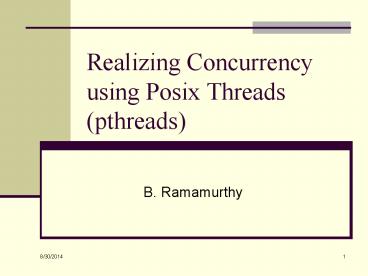Realizing Concurrency using Posix Threads (pthreads) - PowerPoint PPT Presentation
Title:
Realizing Concurrency using Posix Threads (pthreads)
Description:
Realizing Concurrency using Posix Threads pthreads – PowerPoint PPT presentation
Number of Views:60
Avg rating:3.0/5.0
Title: Realizing Concurrency using Posix Threads (pthreads)
1
Realizing Concurrency using Posix Threads
(pthreads)
- B. Ramamurthy
2
Introduction
- A thread refers to a thread of control flow an
independent sequence of execution of program
code. - Threads are powerful. As with most powerful
tools, if they are not used appropriately thread
programming may be inefficient. - Thread programming has become viable solution for
many problems with the advent of multiprocessors
and client-server model of computing. - Typically these problems are expected to handle
many requests simultaneously. Example
multi-media, database applications, web
applications.
3
Topics to be Covered
- Objective
- What are Threads?
- POSIX threads
- Creating threads
- Using threads
- Summary
4
Objective
- To study POSIX standard for threads called
Pthreads. - To study thread control primitives for creation,
termination, join, synchronization, concurrency,
and scheduling. - To learn to design multi-threaded applications.
5
Threads
- A thread is a unit of work to a CPU. It is strand
of control flow. - A traditional UNIX process has a single thread
that has sole possession of the processs memory
and resources. - Threads within a process are scheduled and
execute independently. - Many threads may share the same address space.
- Each thread has its own private attributes
stack, program counter and register context.
6
Pthread Library
- a POSIX standard (IEEE 1003.1c) API for thread
creation and synchronization. - API specifies behavior of the thread library,
implementation is up to development of the
library. - Common in UNIX operating systems.
- Simply a collection of C function.
7
Creating threads
- Always include pthread library
- include ltpthread.hgt
- int pthread_create (pthread_t tp, const
pthread_attr_t attr, void (
start_routine)(void ), void arg) - This creates a new thread of control that calls
the function start_routine. - It returns a zero if the creation is successful,
and thread id in tp (first parameter). - attr is to modify the attributes of the new
thread. If it is NULL default attributes are
used. - The arg is passing arguments to the thread
function.
8
Using threads
- 1. Declare a variable of type pthread_t
- 2. Define a function to be executed by the
thread. - 3. Create the thread using pthread_create
- Make sure creation is successful by checking the
return value. - 4. Pass any arguments need through arg (packing
and unpacking arg list necessary.) - 5. include ltpthread.hgt at the top of your
header. - 6. Compile
- g -o executable file.cc -lpthread
9
Threads local data
- Variables declared within a thread (function) are
called local data. - Local (static) data associated with a thread are
allocated on the stack. So these may be
deallocated when a thread returns. - So dont plan on using locally declared variables
for returning arguments. Plan to pass the
arguments thru argument list passed from the
caller or initiator of the thread.
10
Thread termination (destruction)
- Implicit Simply returning from the function
executed by the thread terminates the thread. In
this case threads completion status is set to
the return value. - Explicit Use thread_exit.
- Prototype void thread_exit(void status)
- The single pointer value in status is available
to the threads waiting for this thread.
11
Waiting for thread exit
- int pthread_join (pthread_t tid, void
statusp) - A call to this function makes a thread wait for
another thread whose thread id is specified by
tid in the above prototype. - When the thread specified by tid exits its
completion status is stored and returned in
statusp.
12
The Thread Model
- (a) Three processes each with one thread
- (b) One process with three threads
13
Per process vs per thread items
- Items shared by all threads in a process
- Items private to each thread
14
Implementing Threads in User Space
- A user-level threads package
15
Implementing Threads in the Kernel
- A threads package managed by the kernel
16
Hybrid Implementations
- Multiplexing user-level threads onto kernel-
level threads
17
Scheduler Activations
- Goal mimic functionality of kernel threads
- gain performance of user space threads
- Avoids unnecessary user/kernel transitions
- Kernel assigns virtual processors to each process
- lets runtime system allocate threads to
processors - Problem Fundamental reliance on kernel
(lower layer) - calling procedures in user space (higher
layer)
18
Pop-Up Threads
- Creation of a new thread when message arrives
- (a) before message arrives
- (b) after message arrives
- Thread pools
19
Thread Scheduling (1)
- Possible scheduling of user-level threads
- 50-msec process quantum
- threads run 5 msec/CPU burst
20
Thread Scheduling (2)
- Possible scheduling of kernel-level threads
- 50-msec process quantum
- threads run 5 msec/CPU burst
21
Summary
- We looked at
- thread-based concurrency.
- Pthread programming
- Implementation of threads.
- We will look at a pthread programming demo
- Study the details given in thread library link.































